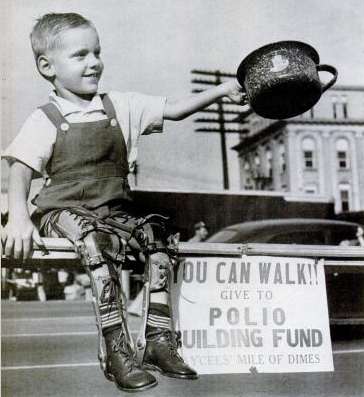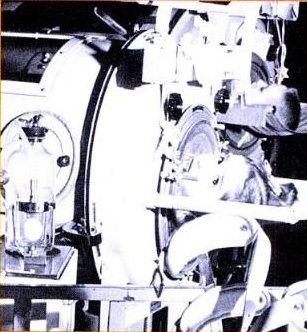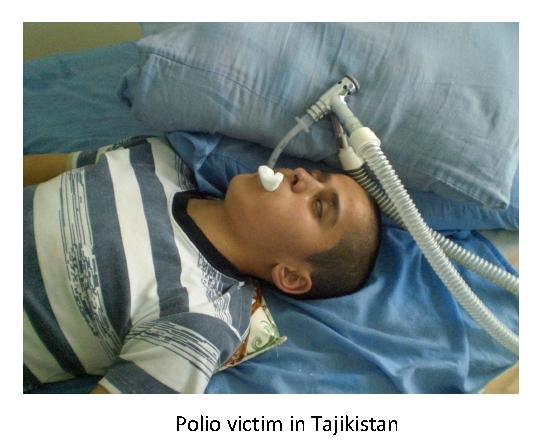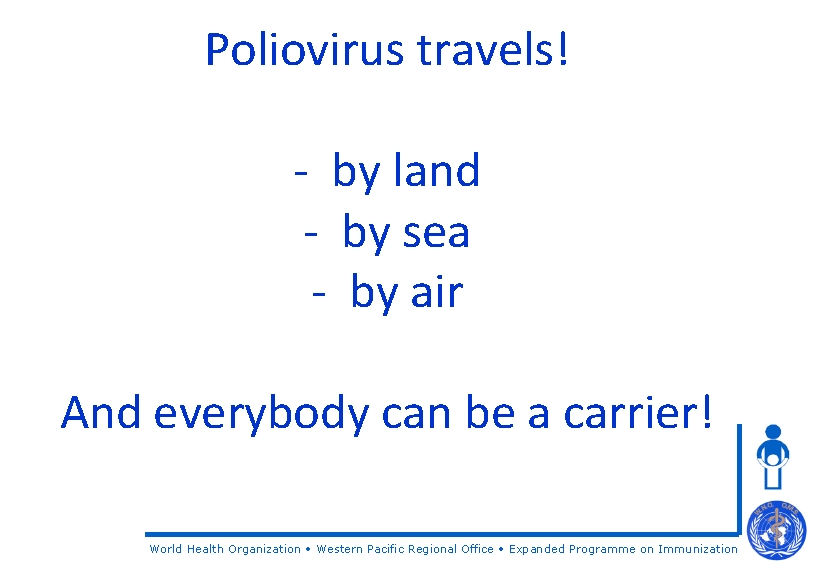There is no cure, the only way to avoid serious complications is prevention, ie, vaccination.
The infection occurs through the alimentary tract. There is no evidence that flies can passively contribute to the supply, contaminating the food. The viruses multiply in the intestinal mucosa but also in the oropharyngeal mucosa (throat and nose), then the infection occurs primarily via the fecal-oral but for a longer period limited, can also occur through droplets of saliva, for example by coughing or sneezing. Persons infected with polio virus to eliminate a few weeks in the faeces. Even those who do not manifest symptoms of the disease - in 95% of those infected the infection has an asymptomatic course (unreal) - can transmit the virus.
------------------------------------------ --------------
Before you continue reading the article, I inform you that since 10.1.11, the Veneto Region has developed an online questionnaire for parents immunizations.
Please participate and run the link as much as possible.
----------------------------------------------- ---------
polioviruses are very stable so they can stay long in the environment or food. This feature facilitates the transmission. The poor hygiene increases the risk of infection. In all the countries of the world , children under two years of age create a microenvironment of poor hygiene within families e all'interno degli asilo nido favorendo il contagio oro-fecale e oro-orale (bocca-mani-bocca).
Vedi: The immunological basis for immunization series: Poliomyelitis
In circa uno su 200 infettati i virus arrivano attraverso il sangue al sistema nervoso centrale dove distruggono motoneuroni, provocando la paralisi flaccida. Nella maggior parte dei colpiti la paralisi riguarda una o anche entrambe le gambe. Nel 5-10% dei casi con paralisi, i virus paralizzano i muscoli dell'apparato respiratorio. Questi pazienti muoiono soffocati. Molti di loro sono sopravvissuti grazie all'invenzione del iron lung . Some had spent all my life, like the woman in this video that had been infected when she was 3 years before the vaccine was available:
A victim of polio, which helps raise money for the "March of Dimes," a fund for research into the prevention of polio:
Some children in iron lungs:
In 1955 was approved Salk vaccine (inactivated virus) and 1961 and 62 Sabin vaccine (live attenuated virus). Both vaccines have taken the names of doctors who direct their research. Both Dr. That Dr. Jonas Salk. Albert Sabin gave up their rights, and so both vaccines have been donated to humanity. The credit for the development of polio vaccines is not just about these two doctors, but many people have over time a very important contribution to these results.
In Italy, was initially used the Salk vaccine (IPV) since 1964 and the Sabin (OPV-before the monovalent vaccines, one for each of the three viruses that cause polio and then the three-way).
From 1999 to 2002 was used for the first two doses the Salk but the enhanced (e-IPV), which is much more effective than the first version, and the third on Sabin, to reduce the number of paralysis from vaccine in Italy during the 96 +97 +98 was 7 cases; thus exceeding the incidence found, which is 1 in 650,000 vaccinated.
It 'still a proof of the exceptional effectiveness of this vaccine after a few years since the number of cases fell and after 1982 there were only cases of vaccine-poliolmielite and even thousands of cases of a that occur each year in Italy in the era prevaccinale. The fact that for many years in Italy were the only cases of polio due to vaccine, used very frequentemente e con grande enfasi dagli antivaccinisti per denigrare la vaccinazione antipolio e - per associazione - tutte le vaccinazioni. Non si rendono minimamente conto che con questo argomento non fanno altro che ammettere l'eccezionale efficacia del vaccino: I CASI DI POLIOMIELITE NON CI SONO PIU' - un grandissimo successo della vaccinazione. I polmoni d'acciaio sono finiti nei musei e - per aver avuto l'opportunità di essere stati vaccinati - milioni di persone camminano oggi invece di essere paralizzati dal virus.
Dal giugno del 2002 viene usato esclusivamente il SALK. Il motivo per questa ulteriore modifica del calendario vaccinale è che il 21 giugno 2002 la Regione WHO Europa è stata dichiarata polio-free thus were no longer justified in cases of paralysis due to the Sabin vaccine as they were rare. The Salk - being composed of inactivated virus - can cause paralysis.
In 1988 the World Health Organization began a campaign to the global eradication of polio . beginning of this initiative in more than 125 countries were polio endemic (= widespread, rooted). Today, only 4 countries (Nigeria, India (most of which are now polio-free), Pakistan and Afghanistan (now almost all polio-free). Unfortunately there are some countries already polio-free years, in which the Recent viruses have been re-imported from endemic countries.
Today many people do not realize how much anxiety they experienced parents and children when the summer was approaching and there was concern the next epidemic of polio that would leave thousands of children paralyzed and killed many others.
So some parents who live in countries where for many years there are more cases of polio, now wonder whether it still makes sense to vaccinate and if the risks of the vaccine do not outweigh the risks of contracting polio. It 's a legitimate question (if it is expressed by a parent) and follows a logic that the individual may also have a "sense": Today, in Italy, thanks to the high vaccine coverage, children vaccinated against polio are not at great risk of becoming ill, as long as there are few. These children are relatively protected because they are surrounded by millions of others who have been vaccinated and that form the barrier between the virus and not vaccinated. With the increase in the number of unvaccinated children, the risk increases gradually.
must never forget that, even if the cases do not see with our eyes, polio still exists in the world. Just one person amounts the virus (for example from a trip to India) and the disease could take it back foot - as has already happened in many countries - if we do not maintain high immunization coverage. This person does not necessarily presenting symptoms of the disease to spread viruses. In fact, the vast majority of infected are asymptomatic and do not even know to be infected (and contagious!). So this person can spread the virus to many people before it presents the first case of paralysis.
Children in Italy since 2002 with the Salk vaccine, are protected mainly by the paralytic form of polio, because they have developed antibodies that circulate in the blood and eliminate the viruses they encounter. But this vaccine - as opposed to Sabin - by only a modest level of immunity to the intestinal mucosa. So even in vaccinated viruses can multiply in the gut, and thus spread in the population. If this happens, children are not vaccinated, not having protective antibodies, are at risk of paralysis if they are infected.
fact, for the eventuality that may arise a case of polio in Italy, there is a sufficient supply of vaccine Sabin to organize mass vaccination of emergency and thus block further spread.
In Holland, for example, despite a vaccination coverage of 97% (approx) for many years, there have been several outbreaks of polio in an area inhabited by a minority belonging to a community religious refusing vaccinations (the so-called bible belt). None of the cases era vaccinato:
Nel 1971 a Staphorst (39 casi di cui 5 morti):
Qui si può guardare un video di un'intervista ad una vittima di quell'epidemia
Fonte: http://www.rivm.nl/en/infectious-diseases/topics/polio/
Nel 1978 (110 casi):
Anche quest'epidemia ha riguardato i membri di una delle comunità religiose che rifiuta le vaccinazioni, solo che al contrario di quanto era successo nelle epidemie del 1971 e 1992-93, questa viveva in mezzo alla popolazione che non apparteneva alla loro comunità. Tutti i 110 casi di polio appartenevano a questa comunità religiosa. Non c'era invece nemmeno un caso fra quella minoranza di olandesi che non era vaccinata per altri motivi (non religiosi). La spiegazione per questo fenomeno non è (come scrive il dott. Eugenio Serravalle nel suo libro "Bambini super-vaccinati") che i membri della comunità religiosa " vivevano in precarie condizioni igieniche" (sono invece normali cittadini con rubinetti in casa dai quali esce la stessa identica acqua). Il motivo è che anche se sono sparsi nella zona, ci sono frequenti contatti fra queste famiglie e ci si incontra anche in chiesa etc. I non vaccinati che non appartengono a questa comunità religiosa invece non hanno stretti contatti con i membri of this community nor do they attend to each other, but the individuals are separated from each other, surrounded and protected by well-vaccinated (ca. 97%). This example illustrates perfectly why it is important to continue to vaccinate all children, even when you live in a polio-free. E 'poliofree just for the fact that almost the entire population is vaccinated and will remain poliofree only if you continue to vaccinate.
in 1992-93 (71 cases including 2 deaths and 59 paralyzed):
poliomyelitis outbreak in an unvaccinated community in the Netherlands , 1992-93
Oostvogel PM et al. Lancet - 3 September 1994 Vol 344, Issue 8923, Pages 665-670
Other European examples where after so many years without a case of polio, there have been cases, Sweden (2 cases in 1977), Finland (9 cases in 1984/85), and now some countries in the Europe Region:
Outbreak Notice Polio Outbreak in Tajikistan, Cases in Russia Risk of spread to other Central Asian Countries
In 2009 the Commission for certification of polio eradication in the WHO European Region had expressed concern about Tajikistan and the country was classified as high risk of polio, if the virus were to be imported. The reason for this assessment was that the vaccine coverage - which had traditionally been very high - in recent years had fallen and was between 85 and 90%. In April of 2010 was the first confirmed case of polio (imported from India) from the wild virus type 1. The virus has spread and in total there were 458 cases incl. 27 dead. In the latter case (Until now) the symptoms started on 4.7.10. As soon as the first case of polio had been confirmed, the fire alarm and were organized mass vaccination. Nobody has refused to vaccinate their children, the vaccine was total acceptance of the offer and had to open additional clinics for vaccinations in order to meet the great demand. The virus has been exported from this epidemic in other neighboring countries (the Russian Federation (14 cases), Turkmenistan (3 cases), Kazakhstan (1 case). Due to the high vaccination coverage in these countries, the virus could not spread as he has in Tajikistan. precaution in these and other neighboring countries were made vaccinations di massa, per aumentare il livello di immunità e per coprire ev. zone con bassa copertura vaccinale.
Il seguente grafico mostra l'andamento dell'epidemia a Tajikistan. In rosso i casi di paralisi flaccida in cui il virus selvaggio del tipo 1 è stato confermato dal laboratirio. In marrone i casi paralisi flaccida causata dal vaccino (OPV), anche questi del tipo1. In verde i casi di paralisi flaccida in cui il risultato di laboratorio è stato negativo al poliovirus. SIA è l'abbreviazione per supplementary immunization activities , cioè le campagne di vaccinazione di massa. L'effetto si può vedere benissimo.
Fonte: WHO Epidemiological Brief 8 of October 6, 2010
These facts are clear: It 's very important to remain vigilant and continue to vaccinate children.
Translation:
The poliovirus travels!
- by land by sea by air
and anybody can be a carrier!
... until there is a single child who has polio, children all over the world are at risk of polio. (WHO)
follow other posts that will examine in detail the various rumors about polio vaccine.
follow other posts that will examine in detail the various rumors about polio vaccine.





0 comments:
Post a Comment